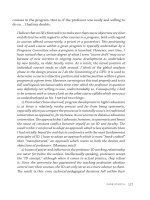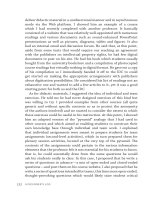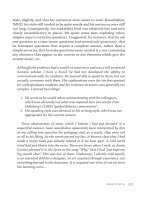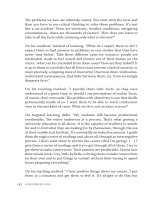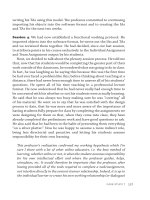A Designer’s Log Case Studies in Instructional Design- P27 potx
Bạn đang xem bản rút gọn của tài liệu. Xem và tải ngay bản đầy đủ của tài liệu tại đây (230.39 KB, 5 trang )
117
CASE STU DY 5
Notes
1. is categorisation is based on work by L. P. Reiber (1994).
2. To preserve the anonymity of the participants in this research
project, I cannot present the schematisations produced during our
working sessions. In Appendix A, however, I have added examples of
various graphic representations that I have developed from concepts
linked to various domains under other circumstances.
I Did It My Way
121
CASE STU DY 6
Case Characteristics
e prole of the professor in Case was quite dierent from that of the
other cases (see Table ). For instance, it was the rst time that I had
been involved in a case of this type. e professor was well into his career
and had considerable time available for our work on the design process.
In addition, unlike most of the others, he had previously taught at a
distance. Despite these dierences, there were also some similarities. is
professor, like the others, had a minimal knowledge of the instructional
design process. Although he was an experienced professor who,
throughout his career, had developed a signicant number of courses
for institutions around the world, he had never developed a course in
conjunction with an ID, nor in coordination with a technical support
team. From the very beginning of our sessions, the professor expressed
misgivings and was decidedly cautious (his guard was denitely up). Like
his peers, he too had to design his course for organisational reasons. Also
important was the fact that his course would be oered overseas.
Table 11: Characteristics of the subject matter expert
Gender Rank Reason Time Availability
No. of
sessions
K/
Design
K/
DE
GO/
SO
M FP O 2 3 8+ 2 2 1
Gender: male Number of sessions = 8+
Rank: FP = full professor Knowledge of Design 2 = intermediate level
Reason: O = organisational Knowledge of DE: 2 = already oered one
Time-to-delivery: 2 = beginning in 2 to 4 months or two courses at a distance
Availability: 3 = 31 to 45 hours General Obj. /Specific Obj.: 1 = no objectives
Although some of these characteristics might normally be considered
advantageous to course design and development, once again, a familiar
scenario seemed to be emerging: we only had a few months ahead of us
to get the work done. is time constraint, which has become a constant
organisational feature (as in “plague”) since the beginning of this study,
created dicult conditions for proper course design.
Before our rst meeting, I asked the professor, as usual, to send me a
copy of his current course syllabus. Against my better judgement, I also



